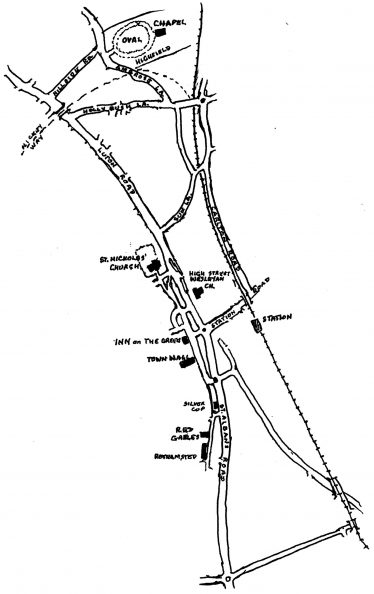
In celebration of European Heritage Weekend (12-15 September 2013), the Society arranged a series of visits to sites associated with Frank Salisbury, which participants found “immensely interesting” and “a very memorable day”. The programme was arranged by Margaret Pratt on behalf of the Society.
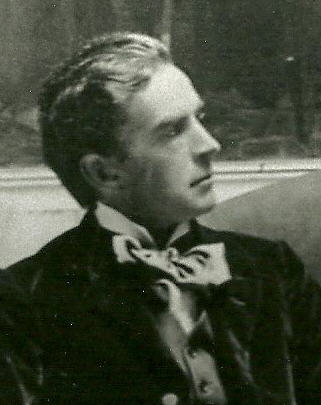
Detail from self portrait
Frank Salisbury was born in Harpenden, did his early training and built his first studio here. He and then moved to St John`s Wood and later to Hampstead, to be more easily accessible for “sitters”. He painted many of the Royal family, the Silver Jubilee of King George V and Queen Mary in St Paul’s Cathedral, the Coronation of George VI and Queen Elizabeth in Westminster Abbey, Prime Ministers, American Presidents, and both dignitaries and local people. His first love was designing stained glass, but he soon realised that portrait painting was more lucrative. Several of his portraits are in the National Portrait Gallery, including Montgomery, and his patron, Sir John Bennett Lawes as a young man. He died in 1962 and is buried in St Nicholas Churchyard.
Birthplace

Frank is the toddler with his family, c. 1876, outside his birthplace – the rear of The Inn on the Green
Tours each day started outside The Inn on the Green, Leyton Road. Frank, the ninth of eleven children of Henry and Susan Salisbury, was born in the cottages at the rear in 1874. He briefly attended the nearby British School (Park Hall), before becoming apprenticed to his eldest brother James who ran a Stained Glass studio at 50 Alma Road, St Albans. James sent him to Heatherly’s School of Fine Art in London: from there he won a scholarship to the Royal Academy school. His first studio was in the loft of an outbuilding behind the Inn on the Green (later Hawes and Harris Stained Glass studio).
Harpenden Town Hall
In the foyer to the Council Chamber hang two very large, signed colour prints of major pageant paintings: ‘Silver Jubilee of King George and Queen Mary’ in St Paul’s Cathedral (1935), and ‘The Coronation of George VI and Queen Elizabeth’ (1937). In the Council Chamber there is a portrait in oils ‘The Lady in Red’.
High Street Methodist Church
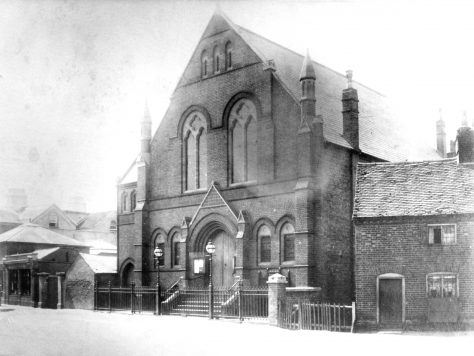
Wesleyan chapel, Leyton Road, dedicated in 1886
Henry Salisbury and his family were staunch Methodists, attending the Wesleyan chapel in Leyton Road (site of Waitrose). Windows designed by Frank for this chapel were transferred to the new High Street Church Hall in 1930.
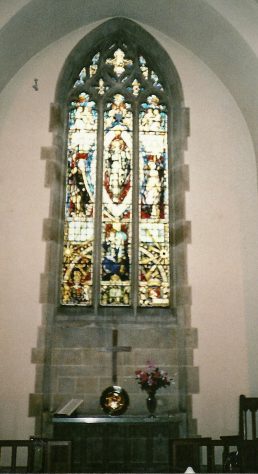
East window, Harpenden High Street Methodist Church
He designed two windows for the new Church: in the East is a ‘teaching’ window, with emphasis on biblical quotations, and the West window pays tribute to Leslie Burgin, local methodist and politician. Alison Edmonds gave most illuminating talks on each of the windows.
Red Gables, West Common
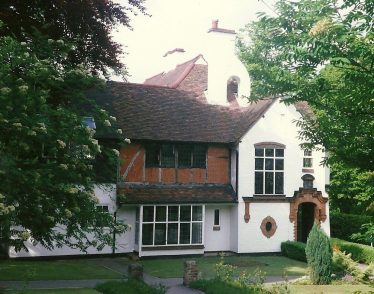
Red Gables, south front
Prof. Roger Plumb of Lawes Agricultural Trust, arranged for the house, designed by Frank and his architect brother Eustace, to be opened. Frank and his family moved here from Elmkirk in Kirkwick Avenue 1907. In the large studio, lit with windows from the north, he painted big canvasses, including “The Nativity” (in St Nicholas Church) and “The Passing of Queen Eleanor”, which was 10 feet (3m) long and hung in St Albans Cathedral until it was stolen in 1973. A stained glass window above the stairs was used to display his skills as a stained glass designer. In 1913, following the death of his infant daughter (who is buried in St Nicholas churchyard), Frank moved to London, with studios first in Avenue Road, St John’s Wood, and then in Sarum Chase, Hampstead, designed and built by his nephew, V Salisbury.
St Nicholas Church
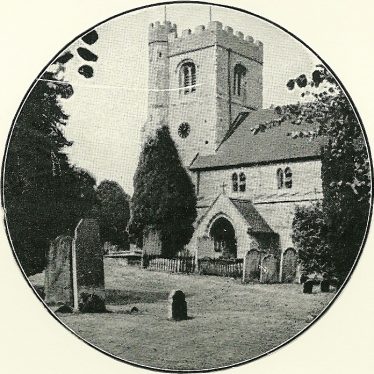
Frank’s parents were married in the parish church in 1863, as the Methodist Chapel was not licensed for marriages. They were the first couple to be married there after the rebuilding of the nave. Frank painted the mural “The Nativity”, now in the Chapel of Private Prayer, on canvas in his studio at Red Gables. It was then marouflaged to the stone wall of what was at that time the vestry, now a chapel for Private Prayer to the left of the altar. Barbara Cotton gave an interesting talk on the symbolism of the painting.
On his death in 1962 Frank Salisbury was buried in the grave of his infant daughter, Elaine, who had died in in 1913. A small gravestone records that his wife Alice Maude (nee Greenwood) was also buried in this grave, and Frank’s death is recorded at the base of the stone, almost invisible at present.
The Chapel, Highfield Oval, Ambrose Lane
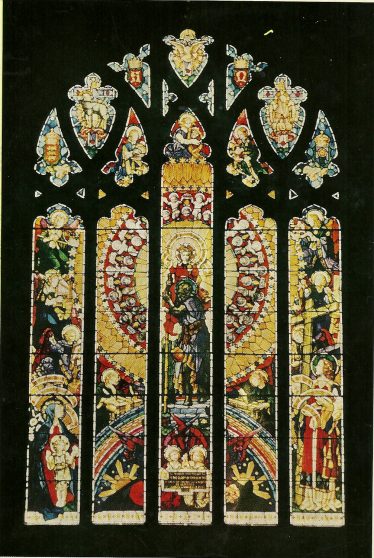
St Christopher window, Highfield Oval Chapel
The National Children’s Home was founded in 1869 in Bethnal Green and moved to Harpenden in 1913. The Methodist benefactor, J Arthur Rank, built the Chapel and at its opening, Frank Salisbury met Lord Wakefield, who became his greatest benefactor. The three-light window “Valour, Justice, Right” (1921) dominates the East end of the chapel, and was dedicated to the memory of 126 Old Boys of the NCH who gave their lives in the Great War.
The St Christopher window at the West end (1928) depicts the patron saint of the NCH as the central figure, walking across a rainbow, and is considered to be Frank Salisbury’s finest stained glass design.
In the mid 1980s, following the closure of the National Children’s Home at Highfield Oval, Youth With a Mission bought the site, including the chapel, which they are maintaining in the tradition of the original founders. They hosted the visit and provided refreshments.

Comments about this page
I have completed my book ‘A Life in Glass’, a biography of my father’s life and work as a stained glass artist. It includes a personal memoir of growing up in Harpenden in the 1950s and 60s. I have taken details from my father’s personal and work diaries. Gerald Coles features in the book as he worked with Harper and Hendra from their studio at 4 High Street (behind The George). My father also painted the window for Medak Cathedral in India, which is mentioned in the comment about Coles.
The cost of the book is £18 plus £3.65 for postage and package. Cheques made payable to myself: Francesca Stevens
Address: 71 Gilbert Road, Cambridge, Cambs CB4 3NZ
Ed note: See Jean Gardner’s review by clicking on the link to “A Life in Glass”
Browsing the history of Hendra and Harper of the Gables, 4 High Street, Harpenden, reading about Frank Salisbury brought back memories of the time when Gerald Coles, an artist who lived in Luton, told me about the great man and the time that he asked Gerald to assist him with a big commission in India and to fly there, but sadly the doctors suggested that he refrained from this journey as the flight alone would have been too much for him as his health at that time was poor.
I would be most grateful if you have any infomation about Hendra or Harper, as I knew the artist Gerald Coles very well.
Ed. Francesca Stevens is writing the biography of her father Geoffrey Harper and has photos of Gerald Coles when he worked with her father. See the comments at the foot of the page about Hawes and Harris.
As sole grandchild of Frank O. Salisbury, I am most impressed by this biography. If you ever require any further information I am available.
Add a comment about this page